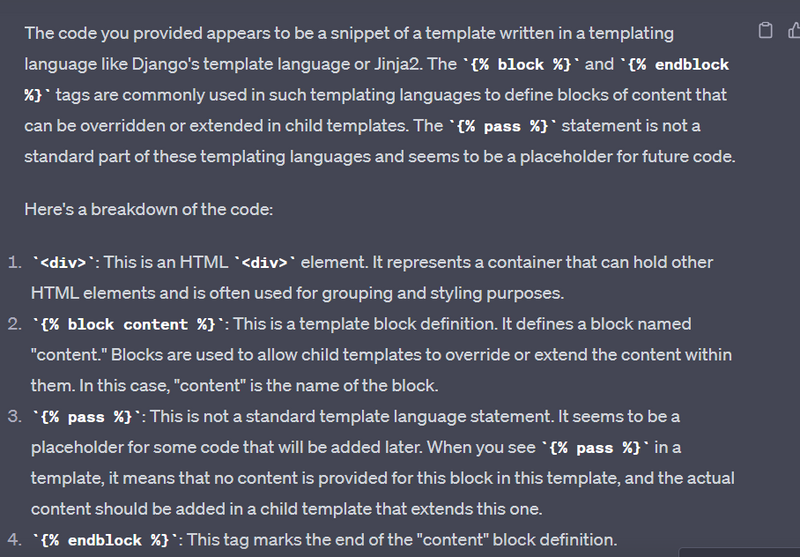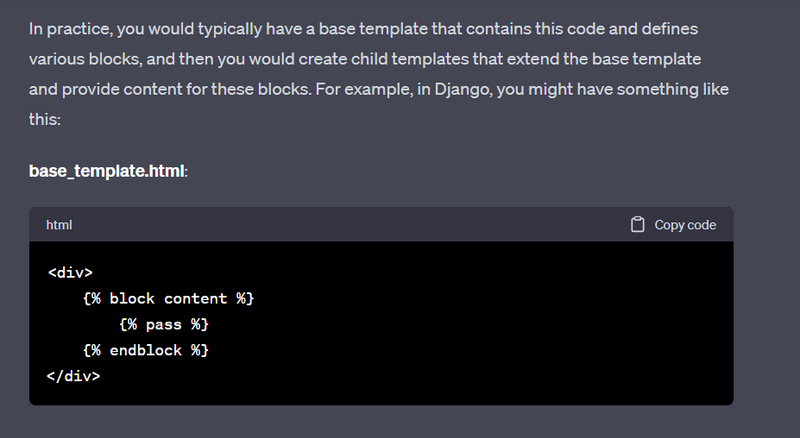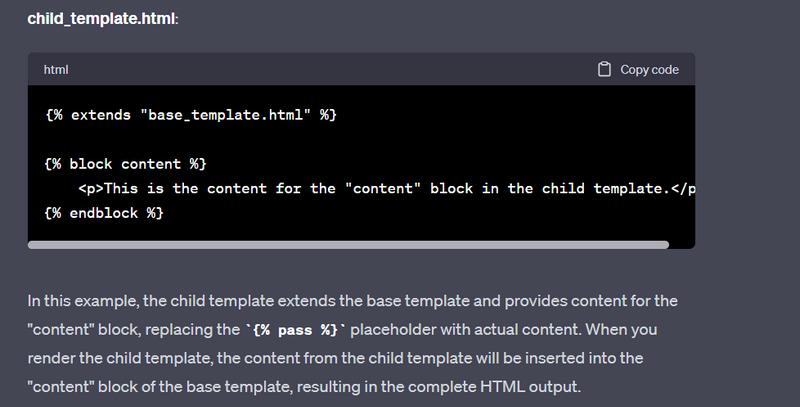In programming, the pass statement is a placeholder or a no-op (no operation) statement that serves as a syntactic requirement but does nothing when executed. It is often used in situations where you need a statement for code structure or syntax reasons, but you don't want to perform any actions or calculations at that point. The pass statement is commonly used in Python and other programming languages.
Summary
if i do not use pass any kind of error occur--
IndentationError or SyntaxError
after function,if,for loop
wihin block in template file
Here's an explanation of the pass statement with examples in Python:
Note
if i do not use pass any kind of error occur
it will result in an
IndentationError or
SyntaxError
because Python expects an indented block to follow the colon.
- Placeholder in Empty Blocks: Sometimes, you may define a block of code, such as a function or a conditional statement, but you haven't implemented the actual functionality yet. In such cases, you can use pass to keep the code syntactically valid until you fill in the details.
def my_function():
pass # To be implemented later
if condition:
pass # Placeholder for future code
- Creating Skeletons for Classes: When defining a class, you might want to create a basic structure with methods or attributes, even if you haven't implemented them yet. pass can be used as a temporary placeholder within the class definition.
class MyClass:
def __init__(self):
pass
def my_method(self):
pass
- Loop Stub: In loops, you might use pass if you want to create an empty loop that doesn't do anything. This can be useful when you are working on a piece of code incrementally and want to add the loop body later.
for item in my_list:
pass # Placeholder for loop body
- Handling Exceptions: In exception handling, you can use pass when you don't want to take any action when an exception occurs. It's generally not recommended to use pass for error handling, but in some cases, it might be necessary.
try:
# Some code that may raise an exception
except SomeException:
pass # Do nothing on exception
- Implementing Abstract Methods: In Python, when you define an abstract base class using the abc module, you can use pass as a placeholder for methods that must be implemented by subclasses.
from abc import ABC, abstractmethod
class MyAbstractClass(ABC):
@abstractmethod
def my_abstract_method(self):
pass # Subclasses must implement this method
Remember that while pass can be helpful as a temporary placeholder, it's essential to replace it with actual code when you are ready to implement the intended functionality. Using pass excessively in your code can make it difficult to understand, so use it sparingly and with clear comments indicating the intended future implementation.
==============================================
In Django, the pass statement is not typically used in the same way as in general Python code because Django is a web framework that follows a specific structure and design pattern. However, there are some scenarios in which you might encounter the use of pass or similar constructs in Django projects:
Placeholder Views:
Django views are responsible for handling HTTP requests and returning HTTP responses. Occasionally, during the initial stages of development, you might create a view function or class-based view but haven't yet implemented the actual logic. In such cases, developers might use pass as a placeholder.
from django.http import HttpResponse
def my_view(request):
# TODO: Implement view logic
pass
However, it's generally advisable to use proper comments like # TODO or # FIXME to indicate that the view is incomplete and needs implementation.
Empty Middleware:
Django allows you to create custom middleware classes to process requests and responses globally. In situations where you want to create the structure of a middleware but haven't yet defined its behavior, you might find pass as a placeholder.
class MyMiddleware:
def __init__(self, get_response):
self.get_response = get_response
def __call__(self, request):
# TODO: Add middleware logic here
pass
As with views, it's better to use comments or docstrings to clarify the purpose of the middleware and indicate that it's incomplete.
Skeleton Templates:
Django templates are used for rendering HTML pages. While developing a Django project, you may create template files with placeholders for HTML, CSS, or JavaScript code that you plan to add later.
<!-- TODO: Add content here -->
<div>
{% block content %}
{% pass %}
{% endblock %}
</div>
Again, comments like <!-- TODO --> are more suitable for indicating that content needs to be added to the template.
Base Classes for Custom Forms or Models:
In Django, you may create custom form classes or models that inherit from Django's built-in form or model classes. You could use pass as a placeholder within these custom classes to indicate that certain methods or fields need to be defined in the subclass.
from django import forms
class CustomForm(forms.Form):
# TODO: Define form fields and validation logic
pass
It's a good practice to add comments or docstrings explaining the expected structure of the subclass.
While the pass statement may appear in these contexts as a placeholder for incomplete code, it's essential to use clear comments and documentation (such as # TODO, # FIXME, or docstrings) to indicate the purpose and intention of the code. This helps maintain code clarity and ensures that incomplete code is addressed in the future.




Top comments (0)